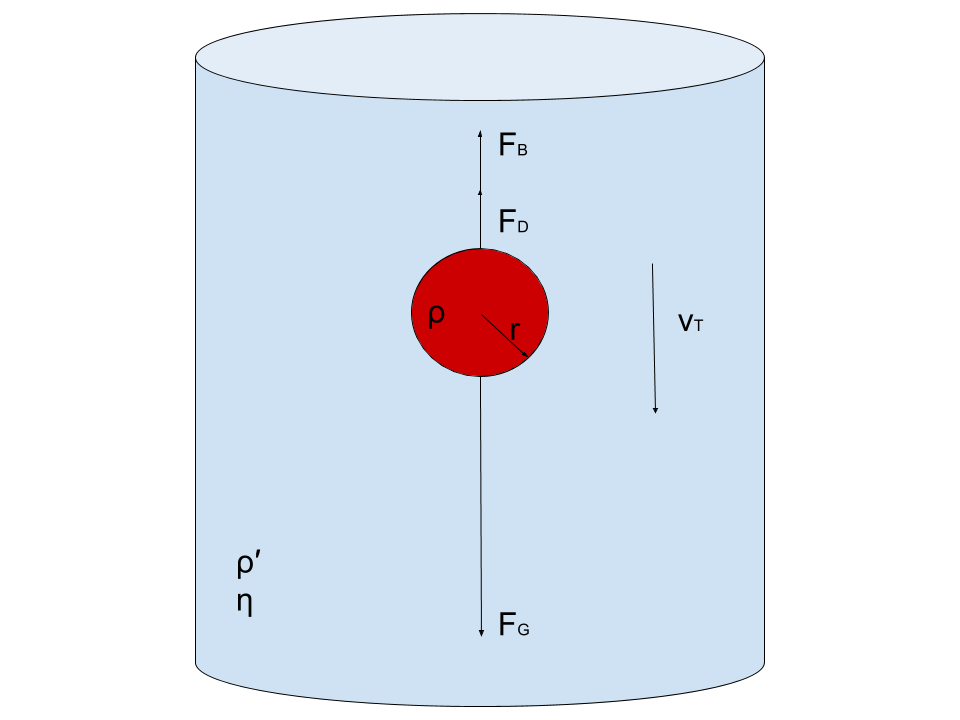Equipment:
- One tube filled with water
- One tube filled with glycerin
- Steel ball
- Teflon ball
- Stopwatch
Demo:
Finding viscosity of a liquid by measuring velocity of small balls sinking in the tall tubes, and applying Stoke’s equation. Two long tubes are filled with fluids of different viscosities, one with water and the other with glycerin. Both tubes have two dark rings a meter apart.
- Drop a ball from the top of the tube
- Start the stopwatch when the ball passes the first ring (this time will be used to calculate the terminal velocity of the ball)
- switch off the stopwatch when the ball passes the second ring
- Record time
- Retrieve ball with net
- Repeat with a different ball
- Ask students why Stoke;s Law will not work for water in this case.
- Using the times recorded in glycerin find the terminal velocity and use that in stokes equation to find the viscosity of glycerin. Also, compare it to the given values in the table below.
- Alternatively use the viscosity of glycerin to calculate the terminal velocity. Is it close to the value you found experimentally?
Explanation:
Viscosity is internal friction inside a fluid. Viscous forces oppose the motion of one portion of the fluid relative to another. Viscosity is denoted by η (eta) as the ratio of the shear stress (Force/Area) to the strain rate. Shear stress is the the friction between fluid particles sliding past each other. It is defined as the force tangent to the material surface divided by the area in which it acts. Strain rate is the rate of change of deformation or strain in a material. It is given as the velocity of the moving surface divided by l (the original length of the material). This equation is given below:
The pascal second [Pa*s] is the SI unit for viscosity.
Viscosity is also very temperature dependent. For gases, when temperature increases the viscosity increases. For liquids, when temperature increase the viscosity decreases. For the purposes of our demonstration we will keep both tubes at room temperature(20° C) with little to no fluctuation in heat.
In glycerin the balls should fall with a constant velocity. In water the same balls will sink with non-uniform motion. In the water the flow is irregular and chaotic, otherwise known as turbulent flow.
Stokes law deals with small spherical objects that are moving through a fluid at small velocities. The reason why it has to be at small velocities is so that the flow is laminar and not turbulent. For that to happen we need to have a small Reynolds number.The viscosity can be determined from the velocity, mass and volume of the ball. Unfortunately for our purposes we cannot show stokes law with water, because the inertial forces dominate over the viscous forces. This means we have a large Reynolds number.
When the ball is moving through the fluid the force of gravity is acting down on it while the forces of buoyancy and drag are acting on it in the opposite direction. The figure below shows this:

At terminal velocity () the net force on the ball is zero. The buoyancy force plus the drag force is equivalent to the weight:
Rearranged:
To make the weight more relatable to the density we can use the relation below:
Where ρ is the density of the ball and V is the volume of the ball (or the amount of water that it displaces.
The drag force is given below:
This is called Stoke’s law.
Where η is the viscosity of the fluid, r is the radius of the ball and is the terminal velocity of the ball in that particular fluid.
Plugging everything into the equation we can then find our expression for Stokes law.
Rearranging the equation above we can then find an expression for the viscosity of the fluid.
Below we have a table with three different balls with different densities and size moving through the glycerin at slow velocities.

Written by Nick McCabe